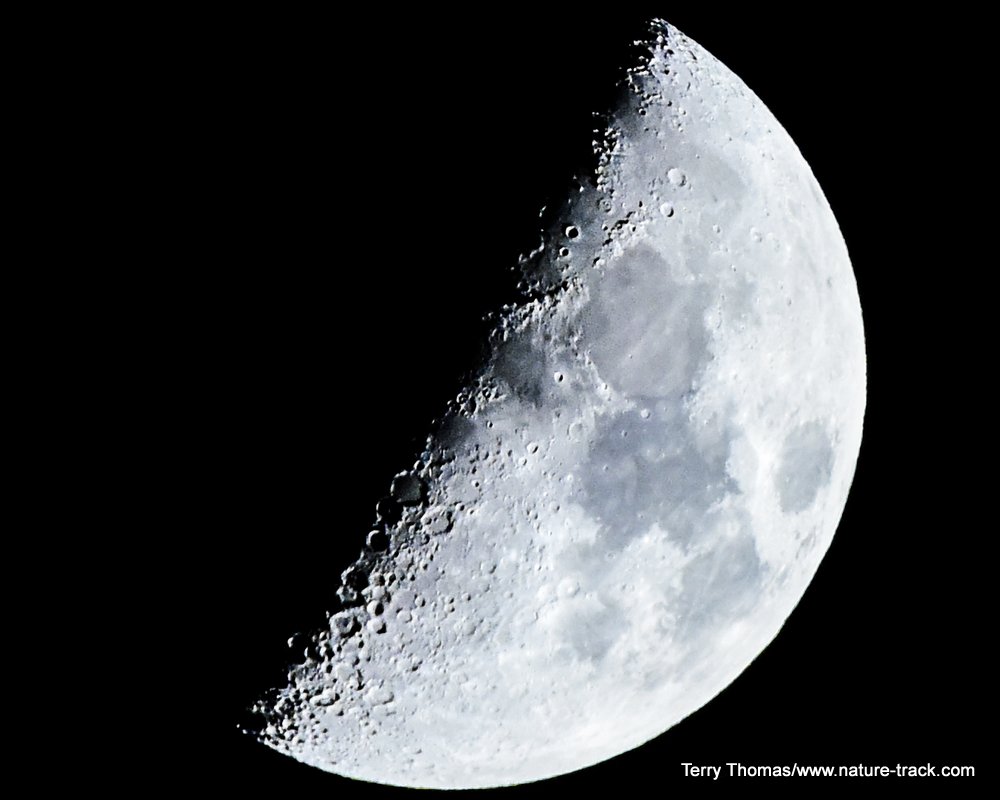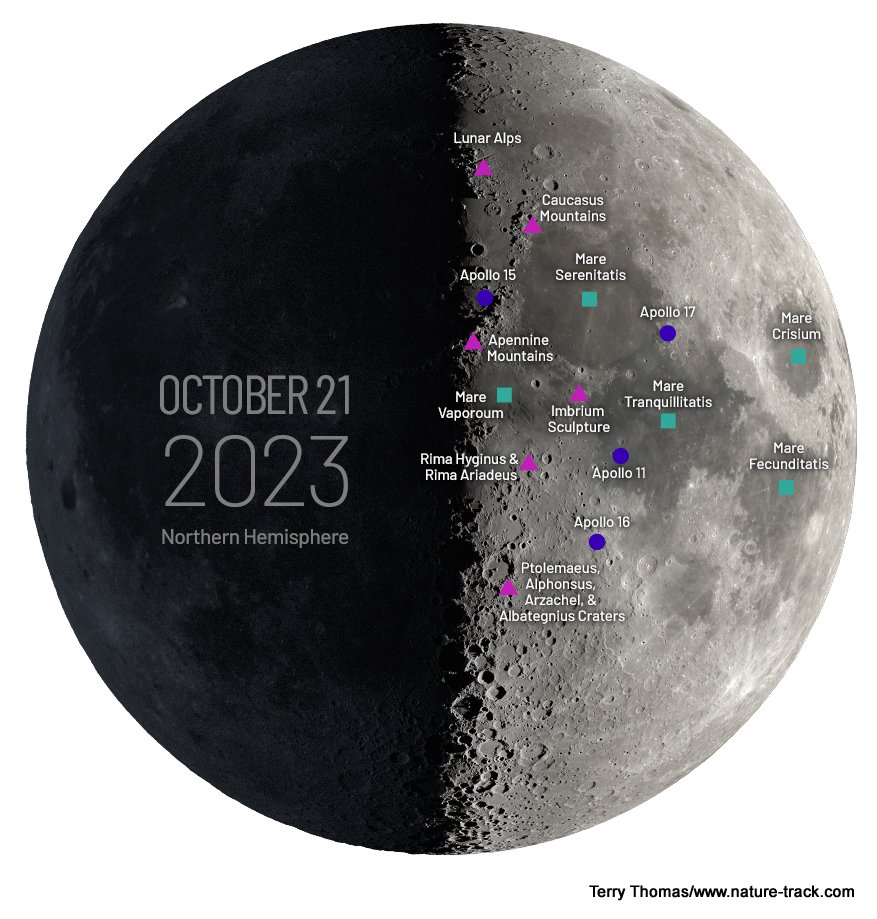How to Best See the Features of the Moon

There are times when the features of the Moon are easier to see and knowing where to look helps (Oct 21, 2023).

Map Courtesy of NASA. Highlights some of the important locations on the Moon visible last week, including Apollo Moon landing sites.
Logic might dictate that the best time to view the Moon and its features is during the full Moon. Perhaps you could go even one better and only observe during a super-moon. However, that isn’t the case. As with photographing landscapes, where high noon is the worst time to capture a landscape because the light is flat (shadowless) causing the image to look that way too, so it is with the Moon. Without shadows, the surface of the Moon will hide a lot of details that can be revealed in better light.
Any time before or after a full or new Moon, you can see a lot more detail in the Moon’s surface. The secret is to observe near the terminator, the line that separates the light and dark sides of the Moon. Near this line, shadows are longest, and consequently, the terrain is in better contrast. In the accompanying image, it is easy to see that the band of terrain close to the terminator reveals a lot more of the complexity of the landscape than the much larger portion that is in full sunlight.
During a waxing Moon, Moonrise occurs during the daylight hours. For instance, last Sunday, Oct 22, Moonrise was at 3:53 p.m. and the Moon was 52.3 percent full, making it a waxing gibbous Moon. On Monday, Moonrise was 4:24 p.m., Tuesday, 4:49 p.m., and so on. By the full Moon, which is Saturday, Moonrise occurs around sunset. On a waning Moon, Moonrise occurs later and later. The final sliver of the waning crescent Moon will occur on Sunday, November 12, and Moonrise won’t occur until 6:35 a.m. Observing a waxing Moon is easier than a waning Moon if getting to bed is important.
As the Moon approaches or declines from full or new, each night we can see a slightly different slice and the terminator line moves, revealing more (waxing) or less (waning) Moon. So, in order to see the entire surface using the terminator, we will need to observe for about 14 days in a row. That might sound a little intimidating, but it is actually a good thing as we can concentrate our efforts on a small portion each day.
The NASA map included here shows a few of the interesting features that were viewable the day I wrote this. “Seas” and craters are readily visible and some are identified. I found it particularly interesting to note where Apollo 11 landed in the Sea of Tranquility on July 16, 1969, and where astronaut Neil Armstrong stepped out onto the surface of the Moon as the first human visitor, declaring, “One small step for [a] man, one giant leap for Mankind.” Apollo 15, 16, and 17 landing locations are also marked. You can find a number of maps on the internet that identify many of the features of the Moon as well as other landing sites.
One of the greatest things about observing the Moon is how relatively close it is to Earth. At a mere 239,000 miles distant, the Moon is close enough that with an ordinary pair of binoculars, you can see many of the features of interest. Last week we started out observing the quarter-Moon with my camera and 600 mm lens. Then we moved up to 10 power binoculars which provided an excellent view, and finished with our spotting scope set at 45 power. With the spotting scope, the Moon filled the entire view and we could make out many details. So, you don’t need a scope that can see astronaut footprints—use the optics that you have and get to know our nearest astrological neighbor. It will be time well spent.
Help Idaho Wildlife
When we traveled across the state in October 2017, we visited most of the Idaho Department of Fish and Game wildlife management areas. Most of the vehicles we saw using the wildlife management areas did not have wildlife plates. Buying wildlife plates is a great way for non-hunters and hunters alike to support wildlife-based recreation like birding.
C'mon folks, let's help Idaho's wildlife by proudly buying and displaying a wildlife license plate on each of our vehicles!
See below for information on Idaho plates. Most states have wildlife plates so if you live outside Idaho, check with your state's wildlife department or vehicle licensing division for availability of state wildlife plates where you live.
And tell them that you heard about it from Nature-track.com!

Wildlife License Plates
Great news! as of 2024, there are three NEW designs for license plates. They still are bluebird, cutthroat trout and elk, but they are beautiful.
Idaho Wildlife license plates provide essential funding that benefits the great diversity of native plants and wildlife that are not hunted, fished or trapped—over 10,000 species or 98% of Idaho’s species diversity. Game species that share the same habitats (such as elk, deer, antelope, sage-grouse, salmon, trout) also benefit from these specialty plates.
No state tax dollars are provided for wildlife diversity, conservation education and recreation programs. Neither are any revenues from the sale of hunting or fishing licenses spent on nongame species. Instead, these species depend on direct donations, federal grants, fundraising initiatives—and the Idaho Wildlife license plates.
Both my vehicles have Bluebird Plates. I prefer the bluebird because the nongame program gets 70 percent of the money from bluebird plates, but only 60 percent of the money from elk and trout plates - 10 percent of the money from elk plates supports wildlife disease monitoring and testing programs (to benefit the livestock industry) and 10 percent from cutthroat plates supports non-motorized boat access.
Incidentally, in 2014, the Idaho Legislature denied the Department of Fish and Game the ability to add new plates or even to change the name of the elk and cutthroat plates (very specific) to wildlife and fish plates, a move that would have allowed for changing images occasionally and generating more revenue. It would seem that they believe that we Idahoans don't want a well funded wildlife program.
I think it is time we let the Legislature know that Idahoan support wildlife funding and that we would like to see these generic plates come to fruition.

"WOW. What a phenomenal piece you wrote. You are amazing." Jennifer Jackson
That is embarrassing, but actually a fairly typical response to my nature essays. Since The Best of Nature is created from the very best of 16 years of these nature essays published weekly in the Idaho Falls Post Register (online readership 70,000), it is a fine read. It covers a wide variety of topics including humorous glimpses of nature, philosophy, natural history, and conservation. Readers praise the style, breadth of subject matter and my ability to communicate complex and emotional topics in a relaxed and understandable manner.
Everyone can find something to love in this book. From teenagers to octogenarians, from the coffee shop to the school room, these nature essays are widely read and enjoyed.
Some of the essays here are my personal favorites, others seemed to strike a chord with readers. Most have an important message or lesson that will resonate with you. They are written with a goal to simultaneously entertain and educate about the wonderful workings of nature. Some will make you laugh out loud and others will bring a tear to the eye and warm your heart.
Readers Write:
"You hit a home run with your article on, Big Questions in Nature. It should be required reading for everyone who has lost touch with nature...great job!" Joe Chapman
"We enjoyed your column, Bloom Where Planted. Some of the best writing yet. The Post Register is fortunate to have your weekly columns." Lou Griffin.
To read more and to order a copy, click here or get the Kindle version
Copies are also available at:
Post Register
Island Park Builders Supply (upstairs)
Barnes and Noble in Idaho Falls
Harriman State Park, Island Park
Museum of Idaho
Valley Books, Jackson Wyoming
Avocet Corner Bookstore, Bear River National Wildlife Refuge, Brigham City, Utah
Craters of the Moon National Monument Bookstore, Arco, Idaho